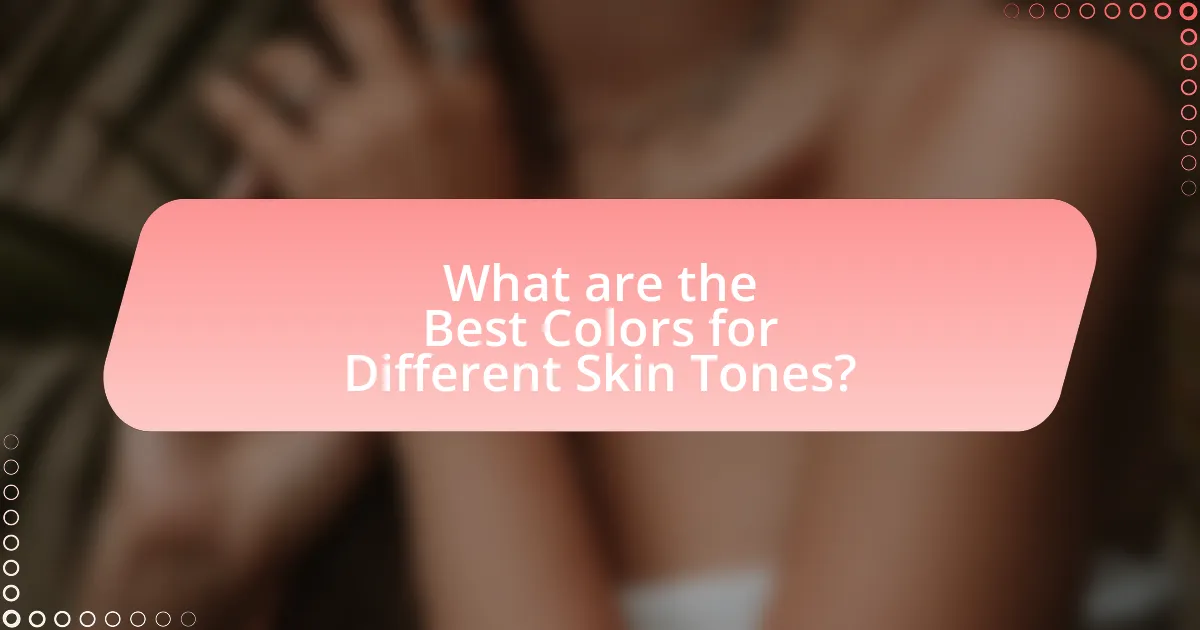Color theory in fashion is the study of how colors interact and their psychological effects, particularly in clothing and personal style. The article explores the principles of color theory, including the color wheel, color harmony, and the significance of skin tone in selecting flattering colors. It discusses how understanding skin tone categories—fair, medium, olive, and deep—can enhance outfit choices and overall appearance. Additionally, the article provides practical methods for determining skin tone and offers tips for matching outfits with skin tones, emphasizing the importance of color choices in boosting confidence and personal expression.

What is Color Theory in Fashion?
Color theory in fashion refers to the study of how colors interact and the psychological effects they have on individuals, particularly in the context of clothing and personal style. This theory is grounded in the color wheel, which categorizes colors into primary, secondary, and tertiary groups, helping designers and consumers understand color relationships, such as complementary and analogous colors. For instance, complementary colors, which are opposite each other on the color wheel, can create striking visual contrasts, while analogous colors, which are next to each other, tend to produce harmonious looks. Understanding color theory allows individuals to choose outfits that enhance their skin tone, convey specific moods, and create cohesive looks, ultimately influencing personal expression and style.
How does color theory influence fashion choices?
Color theory significantly influences fashion choices by guiding individuals in selecting colors that enhance their appearance and express their personality. The principles of color theory, such as the color wheel, complementary colors, and color harmony, help individuals understand which colors work well together and which shades complement their skin tone. For instance, research indicates that warm skin tones typically look better in earthy colors like oranges and yellows, while cool skin tones are enhanced by jewel tones like blues and purples. This understanding allows consumers to make informed decisions that not only reflect their style but also boost their confidence and overall aesthetic appeal.
What are the basic principles of color theory?
The basic principles of color theory include the color wheel, color harmony, and the context of color. The color wheel, developed by Isaac Newton, organizes colors into primary, secondary, and tertiary categories, illustrating their relationships. Color harmony refers to aesthetically pleasing combinations of colors, such as complementary, analogous, and triadic schemes, which create visual balance. The context of color emphasizes how colors can change perception based on surrounding colors and lighting conditions. These principles are foundational in design and fashion, guiding how colors interact and influence mood and style.
How do colors affect perception and mood in fashion?
Colors significantly influence perception and mood in fashion by evoking emotional responses and shaping how individuals are viewed by others. For instance, studies show that warm colors like red and orange can create feelings of excitement and energy, while cool colors such as blue and green tend to promote calmness and tranquility. Research published in the Journal of Experimental Psychology indicates that colors can affect consumer behavior, with specific hues impacting purchasing decisions and brand perception. This demonstrates that the choice of color in fashion not only reflects personal style but also communicates psychological and social cues, affecting both the wearer’s mood and the observer’s perception.
Why is understanding skin tone important in fashion?
Understanding skin tone is crucial in fashion because it directly influences how colors appear on an individual, affecting overall aesthetic appeal. When clothing colors complement a person’s skin tone, they enhance natural features and create a harmonious look, while mismatched colors can lead to an unflattering appearance. Research indicates that certain colors can evoke emotional responses and impact perceptions of attractiveness; for instance, a study published in the Journal of Fashion Marketing and Management found that individuals wearing colors that suit their skin tone are often perceived as more confident and appealing. Therefore, recognizing and applying the principles of skin tone in fashion choices is essential for achieving a polished and visually appealing style.
What are the different skin tone categories?
The different skin tone categories are typically classified into four main types: fair, medium, olive, and deep. Fair skin tones are characterized by light pigmentation and often have pink or peach undertones. Medium skin tones have a balanced mix of warm and cool undertones, while olive skin tones possess a greenish hue and can appear neutral. Deep skin tones are rich and dark, often with warm undertones. This classification is widely recognized in the beauty and fashion industries, aiding individuals in selecting complementary colors for clothing and makeup.
How can skin tone affect color choices in outfits?
Skin tone significantly influences color choices in outfits by determining which hues complement or clash with an individual’s natural complexion. For instance, warm skin tones typically look best in earthy colors like oranges, yellows, and warm reds, while cool skin tones are enhanced by jewel tones such as blues, greens, and purples. This is supported by color theory, which suggests that colors can either harmonize or contrast with skin tones, affecting overall appearance and confidence. Studies in fashion psychology indicate that wearing colors that align with one’s skin tone can enhance perceived attractiveness and personal style.

How to Determine Your Skin Tone?
To determine your skin tone, examine the undertones of your skin, which can be classified as warm, cool, or neutral. Warm undertones typically have a yellow, peach, or golden hue, while cool undertones exhibit pink, red, or blue hues. Neutral undertones are a mix of both warm and cool tones. A simple method to identify your undertone is to look at the veins on your wrist; if they appear green, you likely have warm undertones, while blue or purple veins indicate cool undertones. Additionally, consider how your skin reacts to sun exposure; those who tan easily usually have warm undertones, whereas those who burn may have cool undertones. This classification aligns with color theory in fashion, which emphasizes the importance of matching clothing colors to skin tones for a harmonious appearance.
What methods can you use to identify your skin tone?
To identify your skin tone, you can use methods such as the vein test, the white paper test, and the jewelry test. The vein test involves examining the color of the veins on your wrist; if they appear blue, you likely have a cool skin tone, while greenish veins indicate a warm skin tone. The white paper test requires holding a piece of white paper next to your face; if your skin looks yellowish, you have a warm tone, whereas a pinkish hue suggests a cool tone. The jewelry test involves determining whether gold or silver jewelry complements your skin better; gold typically suits warm tones, while silver is more flattering for cool tones. These methods are widely recognized for their effectiveness in accurately identifying skin tones.
How do undertones play a role in determining skin tone?
Undertones are the subtle hues beneath the surface of the skin that significantly influence the overall skin tone. They can be categorized into three main types: cool, warm, and neutral. Cool undertones typically have hints of blue or pink, warm undertones exhibit yellow or golden hues, and neutral undertones blend both cool and warm tones. Understanding these undertones is essential for selecting complementary colors in clothing and makeup, as they affect how colors appear against the skin. For instance, individuals with cool undertones often look better in jewel tones, while those with warm undertones may prefer earth tones. This relationship between undertones and skin tone is supported by color theory, which emphasizes the importance of matching colors to enhance natural beauty.
What are some common tests to find your skin tone?
Common tests to find your skin tone include the vein test, the white paper test, and the jewelry test. The vein test involves examining the color of veins on the wrist; blue or purple veins indicate a cool tone, while green veins suggest a warm tone. The white paper test requires holding a piece of white paper next to the face; if the skin appears yellowish, it indicates a warm tone, while a pink or rosy appearance suggests a cool tone. The jewelry test involves determining which metal—gold or silver—complements the skin better; gold typically suits warm tones, while silver is more flattering for cool tones. These methods are widely recognized for their effectiveness in identifying skin tones.
Why is it essential to match outfits with your skin tone?
Matching outfits with your skin tone is essential because it enhances your overall appearance and boosts confidence. When clothing colors complement your skin tone, they create a harmonious look that can brighten your complexion and make you appear more vibrant. Studies in color theory indicate that certain colors can evoke emotional responses and influence perceptions of attractiveness. For instance, a 2015 study published in the Journal of Fashion Marketing and Management found that individuals wearing colors that matched their skin tone were perceived as more attractive and approachable. Therefore, aligning outfit colors with skin tone is crucial for achieving a polished and appealing aesthetic.
How does matching colors enhance your overall appearance?
Matching colors enhances your overall appearance by creating a cohesive and harmonious look that complements your skin tone. When colors are well-coordinated, they can highlight your features, improve your complexion, and project confidence. Research indicates that individuals who wear colors that align with their skin tone are often perceived as more attractive and approachable, as supported by studies in color psychology which show that color can influence first impressions and social interactions.
What are the consequences of mismatching colors with skin tone?
Mismatching colors with skin tone can lead to unflattering appearances and diminished confidence. When colors do not complement an individual’s skin tone, it can create a washed-out effect or highlight imperfections, making the person appear tired or unhealthy. Research indicates that color harmony can significantly influence perceptions of attractiveness and professionalism, as noted in studies on color psychology. For instance, a study published in the Journal of Experimental Psychology found that individuals wearing colors that matched their skin tone were perceived as more attractive and competent compared to those who did not. Therefore, selecting colors that align with one’s skin tone is crucial for enhancing overall appearance and self-esteem.

What are the Best Colors for Different Skin Tones?
The best colors for different skin tones include warm, cool, and neutral shades tailored to enhance natural complexion. For warm skin tones, colors like earthy tones, oranges, yellows, and warm reds are most flattering. Cool skin tones benefit from jewel tones such as blues, purples, and cool greens. Neutral skin tones can wear a mix of both warm and cool colors, including soft pastels and muted shades. This classification is supported by color theory, which suggests that color harmony enhances appearance and confidence.
What colors complement warm skin tones?
Colors that complement warm skin tones include earthy shades such as orange, yellow, gold, and warm reds. These colors enhance the natural warmth of the skin, creating a harmonious look. For instance, studies in color theory indicate that warm undertones in skin are best paired with colors that reflect similar warmth, as seen in seasonal color analysis, which categorizes individuals with warm skin tones as “Spring” or “Autumn.” This categorization supports the idea that warm colors resonate well with warm skin tones, making them visually appealing and flattering.
How can you incorporate these colors into your wardrobe?
To incorporate colors that complement your skin tone into your wardrobe, select clothing items in shades that enhance your natural complexion. For example, individuals with warm undertones may benefit from earthy tones like olive green and mustard yellow, while those with cool undertones often look best in jewel tones such as sapphire and emerald. Research indicates that wearing colors that align with your skin tone can improve overall appearance and confidence, as supported by studies in color psychology which show that color can significantly affect perception and mood.
What are some examples of outfits for warm skin tones?
Examples of outfits for warm skin tones include clothing in earthy colors such as olive green, mustard yellow, coral, and warm reds. These colors complement the golden undertones typically found in warm skin tones. For instance, a mustard yellow dress paired with brown accessories enhances the natural warmth of the skin. Additionally, a coral blouse with beige trousers creates a harmonious look that highlights warm undertones. Warm-toned outfits not only enhance the skin’s natural glow but also align with color theory principles that suggest warm colors suit individuals with warm skin tones.
What colors work well with cool skin tones?
Colors that work well with cool skin tones include jewel tones such as emerald green, sapphire blue, and amethyst purple. These colors complement the pink or blue undertones typically found in cool skin tones, enhancing the overall appearance. Additionally, shades like icy pastels, true white, and charcoal gray also suit cool skin tones, as they harmonize with the skin’s natural hues. Fashion experts often recommend these colors because they create a balanced and flattering look, making them ideal choices for individuals with cool undertones.
How can you style outfits using these colors?
To style outfits using specific colors, one should consider the color wheel and the principles of color theory, which suggest that complementary colors enhance each other when paired. For instance, if the chosen color is blue, pairing it with orange accessories can create a vibrant contrast. Additionally, using analogous colors, such as blue and green, can create a harmonious look. According to a study published in the Journal of Fashion Marketing and Management, color combinations significantly affect perceptions of style and attractiveness, indicating that thoughtful color pairing can enhance overall outfit appeal.
What are some outfit ideas for cool skin tones?
Outfit ideas for cool skin tones include colors like jewel tones, icy pastels, and true blacks. Jewel tones such as emerald green, sapphire blue, and amethyst purple complement cool undertones effectively. Icy pastels like lavender, mint green, and baby blue enhance the natural glow of cool skin tones. Additionally, true blacks and crisp whites provide a striking contrast that highlights the coolness of the skin. These color choices are supported by color theory, which indicates that cool skin tones are best paired with shades that have blue or purple undertones, ensuring a harmonious and flattering look.
What colors are suitable for neutral skin tones?
Colors suitable for neutral skin tones include shades like soft white, gray, navy, and blush. These colors complement the balanced undertones of neutral skin, which typically does not lean strongly towards warm or cool tones. For instance, soft white provides a clean contrast, while gray offers a sophisticated neutrality. Navy adds depth without overwhelming the complexion, and blush introduces a subtle warmth that enhances the skin’s natural glow. This information aligns with color theory principles, which emphasize the importance of matching clothing colors to skin undertones for a harmonious appearance.
How can you mix and match colors for neutral skin tones?
To mix and match colors for neutral skin tones, choose colors that complement the undertones of the skin, such as soft pastels, muted tones, and earth shades. Neutral skin tones can balance both warm and cool colors, allowing for versatility in outfit combinations. For example, pairing a soft blush with a muted olive green creates a harmonious look, while a classic navy can be paired with a warm beige for contrast. This adaptability is supported by color theory, which indicates that neutral undertones can harmonize with a wide spectrum of colors, enhancing overall appearance without clashing.
What are some fashion tips for neutral skin tones?
Neutral skin tones can effectively wear a wide range of colors, including both warm and cool shades. To enhance this versatility, individuals with neutral skin tones should focus on colors like soft pastels, muted tones, and earth colors, which complement their balanced undertones. Additionally, jewel tones such as emerald green and sapphire blue can provide a striking contrast without overwhelming the complexion.
Wearing colors like taupe, blush, and navy can also create a harmonious look. Fabrics with a slight sheen, such as silk or satin, can further enhance the overall appearance, as they reflect light beautifully. This approach is supported by color theory, which suggests that neutral skin tones benefit from a broader palette, allowing for more creative expression in fashion choices.

How to Apply Color Theory in Your Wardrobe?
To apply color theory in your wardrobe, start by identifying your skin tone, which can be categorized as warm, cool, or neutral. Once you determine your skin tone, select colors that complement it; for warm skin tones, earthy colors like oranges and yellows work well, while cool skin tones are enhanced by blues and purples. Neutral skin tones can wear a mix of both warm and cool colors. Research indicates that wearing colors that align with your skin tone can enhance your overall appearance and boost confidence, as supported by studies in color psychology that show color can influence perception and mood.
What are some practical tips for matching outfits with your skin tone?
To match outfits with your skin tone effectively, identify whether your skin tone is warm, cool, or neutral. Warm skin tones typically pair well with earthy colors like oranges, yellows, and warm reds, while cool skin tones look best in jewel tones such as blues, purples, and cool greens. Neutral skin tones can wear a mix of both warm and cool colors.
For practical application, consider using a color wheel to find complementary shades. For instance, if you have a warm skin tone, colors opposite on the wheel, like teal or navy, can create a striking contrast. Additionally, testing fabrics against your skin in natural light can help determine which colors enhance your complexion.
Research indicates that color choices can significantly impact perceived attractiveness and confidence, as noted in studies on color psychology in fashion.
How can you create a versatile wardrobe based on color theory?
To create a versatile wardrobe based on color theory, select a color palette that complements your skin tone and includes a mix of neutral and accent colors. This approach allows for easy mixing and matching of outfits. For instance, individuals with warm skin tones may benefit from earthy colors like olive green and warm reds, while those with cool skin tones might opt for jewel tones like sapphire and emerald. Research indicates that a well-defined color palette enhances outfit coordination and personal style, making it easier to create cohesive looks. By focusing on colors that harmonize with your natural complexion, you ensure that each piece in your wardrobe can be paired effectively, maximizing versatility.
What are common mistakes to avoid when choosing colors?
Common mistakes to avoid when choosing colors include neglecting skin tone compatibility, overlooking color psychology, and failing to consider the context of the outfit. Choosing colors that clash with an individual’s skin tone can lead to unflattering appearances; for example, warm skin tones typically look better in earthy colors, while cool skin tones are complemented by jewel tones. Additionally, ignoring color psychology can result in unintended emotional responses; for instance, red can evoke passion, while blue often conveys calmness. Lastly, not considering the occasion can lead to inappropriate color choices; bright colors may be suitable for casual settings but inappropriate for formal events.
How can seasonal trends influence your color choices?
Seasonal trends significantly influence color choices by dictating which hues are perceived as fashionable or appropriate during specific times of the year. For instance, spring often brings pastel colors, while fall is associated with earthy tones. This cyclical nature of color trends is supported by fashion industry reports, such as the Pantone Color Institute’s seasonal color forecasts, which highlight the colors that will dominate each season based on cultural influences and consumer preferences. These trends not only affect individual choices but also shape the overall market, as designers and retailers align their collections with the anticipated seasonal palettes.
What are the current color trends in fashion?
Current color trends in fashion include vibrant shades such as electric blue, rich emerald green, and warm terracotta. These colors have gained popularity in recent collections, reflecting a shift towards bold and expressive palettes. For instance, Pantone’s Color of the Year for 2023, Viva Magenta, emphasizes a strong, lively hue that resonates with themes of empowerment and creativity. Additionally, fashion weeks across major cities have showcased these colors prominently, indicating a collective movement towards embracing vivid tones in everyday wear.
How can you adapt these trends to suit your skin tone?
To adapt trends to suit your skin tone, identify your undertone—warm, cool, or neutral—and select colors that complement it. For warm undertones, earthy tones like oranges, yellows, and warm reds enhance the complexion. Cool undertones benefit from jewel tones such as blues, purples, and cool greens. Neutral undertones can wear a mix of both warm and cool colors, allowing for versatility. Research indicates that wearing colors that align with one’s undertone can enhance overall appearance and confidence, as supported by studies in color psychology which show that color choices can significantly affect perceptions of attractiveness and mood.
What are some final tips for mastering color theory in fashion?
To master color theory in fashion, focus on understanding the color wheel, which illustrates primary, secondary, and tertiary colors, and their relationships. Familiarize yourself with concepts like complementary colors, which enhance each other when paired, and analogous colors, which create harmony. Additionally, consider the psychological effects of colors; for instance, blue often conveys calmness while red signifies energy. Experiment with different color combinations in your wardrobe to see what complements your skin tone best, as this can significantly impact your overall appearance. Lastly, stay updated on seasonal color trends, as they can influence your choices and help you create a modern, cohesive look.
How can you experiment with colors while staying true to your skin tone?
To experiment with colors while staying true to your skin tone, choose shades that complement your undertones. For example, individuals with warm undertones should opt for earthy colors like oranges, yellows, and warm reds, while those with cool undertones should select jewel tones such as blues, purples, and cool greens. This approach ensures that the colors enhance rather than clash with your natural complexion. Research indicates that wearing colors that align with your skin’s undertones can improve overall appearance and confidence, as supported by studies in color psychology.
What resources can help you learn more about color theory in fashion?
Books such as “Color: A Natural History of the Palette” by Victoria Finlay and “The Color Scheme Bible” by Anna Starmer provide foundational knowledge on color theory applicable to fashion. Online platforms like Skillshare and Coursera offer courses specifically focused on color theory in fashion design, allowing learners to engage with interactive content. Additionally, websites like Pantone provide color trend reports and guides that are essential for understanding color relationships and their impact on fashion. These resources collectively enhance comprehension of how color theory influences outfit coordination with skin tones.


